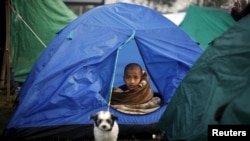They are known as digital humanitarians: the thousands of tech-savvy volunteers from around the world who are both physically and virtually converging on the crisis in Nepal and digging through mountains of data to help humanitarian agencies direct their aid.
If the April 25 earthquake that struck Nepal and killed more than 6,000 people had happened five years ago, the emergency response would have been very different. At that time, one of the biggest hurdles humanitarian agencies faced was a lack of information. When disaster struck, they didn't know for days and weeks who had been affected, how many, how badly or where.
Leveraging Text Messages
Now, thousands of people in Nepal have mobile phones and have used Twitter and other social media to send out millions of messages and pictures of destroyed houses, and themselves. Humanitarian agencies have learned how to leverage that information.
Chris Fabian, who co-leads the innovation unit at UNICEF, says his agency is about to launch in Nepal a mobile phone text message system called U-report.
“U-report is a system that uses basic text messages and allows us to have conversations with kids who might not have access to the Internet, or even full time electricity, but who do have access to a basic mobile phone,” Fabian said from his office in Geneva.
That system, which UNICEF first used in Liberia in response to the Ebola crisis, now has 700,000 users around the world in 13 countries.
Fabian said that mobile phone users across the country will be able to text to the humanitarian agency what kind of issues they are facing, from the extent of the damage in their villages to their most urgent needs.
“We know in Nepal there are 1.7 million children who are in need of urgent aid, but we don’t always know what type of aid that is, and when we can hear from young people what is happening in the camp around them, in the village around them, we can find out that some people may be in need of water supplies, some others may be in need of health supplies, we can start to direct that aid more accurately. It also helps us for planning for building back these communities,” he said.
Sorting Through the Data
But there is also the danger of information overload. Millions of tweets are sent every day. Thousands of photographs are popping up on social media networks. Drone pilots, both professional and amateur, also have rushed to offer their services, using technology to produce reams of aerial photographs.
The challenge is how to comb through all the information and categorize it in such a way that humanitarian agencies can use it effectively in their disaster damage assessments.
Patrick Meier, Director of Social Innovation at the Qatar Computing Research Institute, is one of a new generation of “digital humanitarians” working to make sense of the massive amount of real-time data. One of the technologies he is using is a crowdsourced micromappers site where volunteers from around the world can sift through the incoming data, and curate it.
“We've got over 2,000 volunteers from over 50 countries around the world who have gone onto Micromappers,” Meier said in a phone interview from Doha.
Those volunteers analyze the information coming in, such as tweets and photographs, and categorize it under “urgent needs” or “infrastructure damage.”
But that’s not all, Meier says.
“Underneath Micromappers is an artificial intelligence engine that learns from the digital volunteers, it learns to recognize which tweet belongs in which bucket, and then can automatically tag on its own without any more help, up to some two million tweets per hour, and that’s exactly what’s happening right now,” he said.
Humanitarian Drones
Locally, Kathmandu Living Labs is a group of young innovators using open-source information, mapping and SMS-based tools, to also help pool information and place it on crowdsourced maps.
Meier is also helping coordinate the work of the Humanitarian Unmanned Aerial Vehicles (UAV) Network, an initiative that now has access to a global network of some 900 UAV pilots in 70 countries around the world. Six professional Unmanned Aerial Vehicle (UAV) teams, including two from the United States and one from Switzerland, are expected to be on the ground in Nepal by May 2.
These pilots will supply humanitarian agencies with aerial images of the damage caused by the earthquake.
One of the most recent requests, Meier said, was from a U.S. search and rescue team looking for survivors.
The technology is not only helping the aid groups on the ground, it is also changing how funds are raised to make the aid possible. UNICEF, for example, this week launched an appeal for $415 million. Fabian says by using technology and social media, aid agencies can show in a very personal way what a difference that money can make.
“Being able to highlight an individual human story, the effect of the work we do on the ground, is really vital to our ability to raise funds, and certainly maintain interest in some of these emergencies that go on much past the media horizon, which we all know ends very quickly,” he said.









